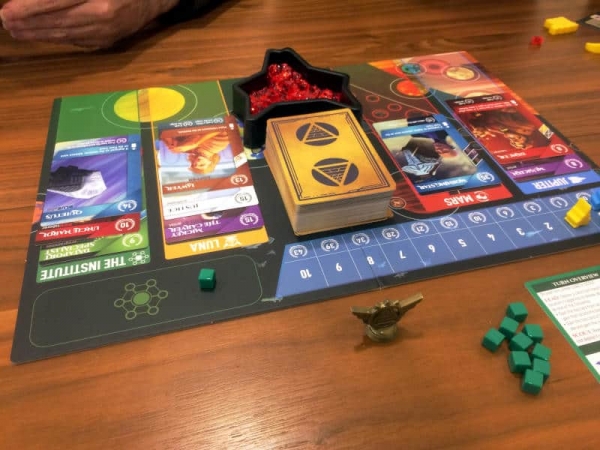As a member of the lowest caste in our colour-coded society, I worked extremely hard every day. I believed that my blood and sweat would create a better world for my children. I prayed that one day, Mars' surface would become habitable. However, my caste and I had been betrayed. I and others like me were nothing more than slaves to a decadent ruling class. So now was the time for my caste to revolt. It was time for the Red Rising by Jamey Stegmaier and Alexander Schmidt from Stonemaier Games.
The Story of Red Rising
The game is based on the 2014 dystopian science fiction novel by American author Pierce Brown of the same name. More specifically, it's based on the first trilogy of books, Red Rising, Golden Son and Morning Star, which are set on Mars some time in the future. The books tell the story of Darrow, who, as my introduction alluded to, is born into the lowest caste of a society that treats them as slaves. However, these Reds, as the lowest caste is called, don't know that they're being exploited. They're kept in ignorance and are fed the lie that their work will help make the planet's surface livable, allowing their children to enjoy a prosperous future.
The background story of Red Rising reminds me a little bit of Euphoria, another of Stonemaier's games. In the latter, you lead a team of workers and recruits to overthrow a dystopian society that tries to keep its people ignorant, because we all know that ignorance is bliss. It wants everyone to believe that they live in a utopia and just like in George Orwell's book 1984, Euphoria's leading class controls people's language by removing words, such as dystopia, from their vocabulary.
So it should be no surprise that Jamey was very impressed with the Red Rising book series. As he has said himself in the past, he has had his heart set on turning them into a game for many years. After a couple of unsuccessful attempts, he worked together with designer Alexander Schmidt to create something that he was really happy with.
Hand Management With Many Twists
Red Rising is very much a hand-management game. You curate your hand by playing a card, using its ability and then taking another card. You pick up cards from either one of the four locations where cards are face-up or the face-down draw deck. That doesn't sound too hard.
However, deciding which card to play can be an excruciating decision. Obviously, you want to play a card with a beneficial ability, play it at the right time and play it in the right location, so that you trigger a powerful combo. Combos are key in Red Rising, because everyone gets the same number of turns. So the more combos you trigger, the more actions you carry out on your turn and the more points you can earn.
However, every card you play will be available to other players. There are ways to bury cards or even banish them from the game, but no card is ever 100% safe from your competitors, not even banished ones. So a really powerful card will be picked it up by someone else and played on a later turn. Mind you, sometimes cards can be really useful to you, but have very little benefit for another player. It will depend on what cards the other player has, which cards are on the board and whether the right time to play the cards has passed. Also, every card is worth a certain amount of points, which is another reason why you might want to hang on to it.
As you get to the end of the game, you tend to have the perfect hand. Playing any of the cards will ruin your plans or give someone else access to a card crucial to them. Every turn becomes a terribly tough decision.
 The fleet track with the plastic spaceship tokens and some of the face-up cards in Red Rising.
The fleet track with the plastic spaceship tokens and some of the face-up cards in Red Rising.
Lots of Cards
There is also a lot to remember. Not only are there 112 cards in Red Rising, but each one also represents a character from one of the 11 different coloured castes. That's a lot of cards and a lot of colours and that's what makes learning the game difficult. Technically, learning Red Rising should be no different to learning other card games like it, but while it took me maybe two games of Mystic Vale to get a really good feeling for how it works, I really struggled with Red Rising.
It's not even the sheer number of cards. It's the number of colours. Like in other card games, in Red Rising, colours group together cards with similar abilities. However, while learning six colours isn't too bad, trying to get used to 11 is tough. It wasn't until the second game that I worked out that pink is about moving cards between locations and that green is about guessing cards. That's two colours out of 11. I'm not even halfway there. Red Rising also takes longer to play than games like Mystic Vale. So you can't just play a few games back to back to help you remember the colours.
I think it would have been good if the rulebook explained what the colours do, at least in broad strokes. I mean, just having a list of all 11 colours on your player aid would have been great. In my first game, I got a green card that asked me to choose three colours. The problem was, I had no idea what colours there were, so I had to choose three of the colours that were in play.
Strangely Addictive
Yet, despite all that, Red Rising is strangely addictive. If you can get through the first couple of games, it does get easier and you start to think about what combos there might be for you to explore. There are also plenty of other things you need to do during a game, other than worry about your hand of cards. You can never do everything, but ideally, you want to play a part in as many different areas of interest as possible. There are three areas that are about having the most influence in, one represented by a track, the other two by having the most tokens. You can't win them all, but you should still not neglect them.
The timing of the game is also spot on. Yes, it does take about an hour to play, but it finishes at the right time and doesn't outstay its welcome. The game starts at quite a pace, slows down a little in the middle and then sprints to the end. It's over quicker than you think sometimes, leaving everyone wanting to play just one more round.
In fact, it's towards the end that Red Rising becomes really exciting. Everyone is trying to work out how many rounds might be left. Everyone wants to get the cards they need or get rid of the cards they don't want to get the most end-of-game points. It reminds me a little bit of Scythe in that respect. It is very possible for you to be the player who decides when the game ends, while everyone else is at your mercy. However, while Scythe ends immediately, in Red Rising you finish the round, which makes it feel less harsh.

High Quality
The component quality is also top-notch, which is Stonemaier Games' hallmark now. The rulebook is printed on the same wonderful paper that we have first seen, and felt, in Wingspan. The game board and house cards are made from really thick cardboard, the cards are from really good card stock and all the plastic components are gorgeous, without being over the top. The plastic dice isn't quite as chunky and wonderful as the wooden ones you get in Wingspan, but it's still lovely to roll. There are also rocketship-shaped tokens, a sickle-moon shape first-player marker, the wonderful Sovereign token and ruby-red plastic gems.
The game doesn't take up much space on the table either. The game board is relatively small and holds pretty much all of the components, except the dice, first-player and Sovereign token. Players hold the cards in their hands and just need a small space for their cube tokens and the gems that they earn during the game. So even with six players, it should easily fit on most people's living room or even kitchen tables.
Red Rising is a game that I will definitely keep in my collection. There is enough to keep you thinking, without being too overwhelming, at least once you got used to all the different colours. Even though the game really clicked with one of my friends, who pretty much immediately loved it, mostly because of the combo potential, it's not the sort of game I would want to play all the time. However, it's definitely the sort of game that will keep coming out of the cupboard again and again. Red Rising, ironically, is going to be an evergreen for me.
 Games
Games How to resolve AdBlock issue?
How to resolve AdBlock issue? 
















